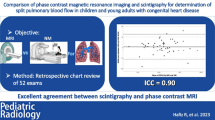Abstract
Background
Lung perfusion scintigraphy is regarded as the gold standard for evaluating differential lung perfusion ratio in congenital heart disease.
Objective
To compare cardiac CT with lung perfusion scintigraphy for estimated pulmonary vascular volume ratio in patients with congenital heart disease.
Materials and methods
We included 52 children and young adults (median age 4 years, range 2 months to 28 years; 31 males) with congenital heart disease who underwent cardiac CT and lung perfusion scintigraphy without an interim surgical or transcatheter intervention and within 1 year. We calculated the right and left pulmonary vascular volumes using threshold-based CT volumetry. Then we compared right pulmonary vascular volume percentages at cardiac CT with right lung perfusion percentages at lung perfusion scintigraphy by using paired t-test and Bland–Altman analysis.
Results
The right pulmonary vascular volume percentages at cardiac CT (66.3 ± 14.0%) were significantly smaller than the right lung perfusion percentages at lung perfusion scintigraphy (69.1 ± 15.0%; P=0.001). Bland–Altman analysis showed a mean difference of −2.8 ± 5.8% and 95% limits of agreement (−14.1%, 8.5%) between these two variables.
Conclusion
Cardiac CT, in a single examination, can offer pulmonary vascular volume ratio in addition to pulmonary artery anatomy essential for evaluating peripheral pulmonary artery stenosis in patients with congenital heart disease. However there is a wide range of agreement between cardiac CT and lung perfusion scintigraphy.



Similar content being viewed by others
References
Vida VL, Rito ML, Zucchetta F et al (2013) Pulmonary artery branch stenosis in patients with congenital heart disease. J Card Surg 28:439–445
Pruckmayer M, Zacherl S, Salzer-Muhar U et al (1999) Scintigraphic assessment of the pulmonary and whole-body blood flow patterns after surgical intervention in congenital heart disease. J Nucl Med 40:1477–1483
Sabiniewicz R, Romanowicz G, Bandurski T et al (2002) Lung perfusion scintigraphy in the diagnosis of peripheral pulmonary stenosis in patients after repair of Fallot tetralogy. Nucl Med Rev Cent East Eur 5:11–13
Fratz S, Hess J, Schwaiger M et al (2002) More accurate quantification of pulmonary blood flow by magnetic resonance imaging than by lung perfusion scintigraphy in patients with Fontan circulation. Circulation 106:1510–1513
Roman KS, Kellenberger CJ, Farooq S et al (2005) Comparative imaging of differential pulmonary blood flow in patients with congenital heart disease: magnetic resonance imaging versus lung perfusion scintigraphy. Pediatr Radiol 35:295–301
Sridharan S, Derrick G, Deanfield J et al (2006) Assessment of differential branch pulmonary blood flow: a comparative study of phase contrast magnetic resonance imaging and radionuclide lung perfusion imaging. Heart 92:963–968
Goo HW (2011) Cardiac MDCT in children: CT technology overview and interpretation. Radiol Clin N Am 49:997–1010
Tsai IC, Goo HW (2013) Cardiac CT and MRI for congenital heart disease in Asian countries: recent trends in publication based on scientific database. Int J Cardiovasc Imaging 29:1–5
Goo HW (2013) Current trends in cardiac CT in children. Acta Radiol 54:1055–1062
Koch K, Oellig F, Oberholzer K et al (2005) Assessment of right ventricular function by 16-detector-row CT: comparison with magnetic resonance imaging. Eur Radiol 15:312–318
Kim HJ, Goo HW, Park S et al (2013) Left ventricle volume measured by cardiac CT in two infants with small left ventricles: a new and accurate method in determining uni- or biventricular repair. Pediatr Radiol 43:243–246
Goo HW, Park SH (2015) Semiautomatic three-dimensional CT ventricular volumetry in patients with congenital heart disease: agreement between two methods with different user interaction. Int J Cardiovasc Imaging 31:223–232
Goo HW, Al-Otay A, Grosse-Wortmann L et al (2009) Phase contrast MR quantification of normal pulmonary venous return. J Magn Reson Imaging 29:588–594
Walker CM, Rosado-de-Christenson ML, Martinez-Jimenez S et al (2015) Bronchial arteries: anatomy, function, hypertrophy, and anomalies. Radiographics 35:32–49
Grosse-Wortmann L, Al-Otay A, Yoo SJ (2009) Aortopulmonary collaterals after bidirectional cavopulmonary connection or Fontan completion: quantification with MRI. Circ Cardiovasc Imaging 2:219–225
Valverde I, Nordmeyer S, Uribe S et al (2012) Systemic-to-pulmonary collateral flow in patients with palliated univentricular heart physiology: measurement using cardiovascular magnetic resonance 4D velocity acquisition. J Cardiovasc Magn Reson 14:25
Hayabuchi Y, Inoue M, Watanabe N et al (2010) Assessment of systemic-pulmonary collateral arteries in children with cyanotic congenital heart disease using multidetector-row computed tomography: comparison with conventional angiography. Int J Cardiol 138:266–271
Hwang B, Lee PC, Fu YC et al (2004) Transcatheter implantation of intravascular stents for postoperative residual stenosis of peripheral pulmonary artery stenosis. Angiology 55:493–498
Froelich JJ, Koenig H, Knaak L et al (2008) Relationship between pulmonary artery volumes at computed tomography and pulmonary artery pressures in patients with- and without pulmonary hypertension. Eur J Radiol 67:466–471
Park S, Lee SM, Kim N et al (2013) Automatic reconstruction of the arterial and venous trees on volumetric chest CT. Med Phys 40:071906
Goo HW, Yang DH, Park IS et al (2007) Time-resolved three-dimensional contrast-enhanced magnetic resonance angiography in patients who have undergone a Fontan operation or bidirectional cavopulmonary connection: initial experience. J Magn Reson Imaging 25:727–736
Author information
Authors and Affiliations
Corresponding author
Ethics declarations
Conflicts of interest
None
Rights and permissions
About this article
Cite this article
Goo, H.W., Park, S.H. Pulmonary vascular volume ratio measured by cardiac computed tomography in children and young adults with congenital heart disease: comparison with lung perfusion scintigraphy. Pediatr Radiol 47, 1580–1587 (2017). https://doi.org/10.1007/s00247-017-3912-z
Received:
Revised:
Accepted:
Published:
Issue Date:
DOI: https://doi.org/10.1007/s00247-017-3912-z




